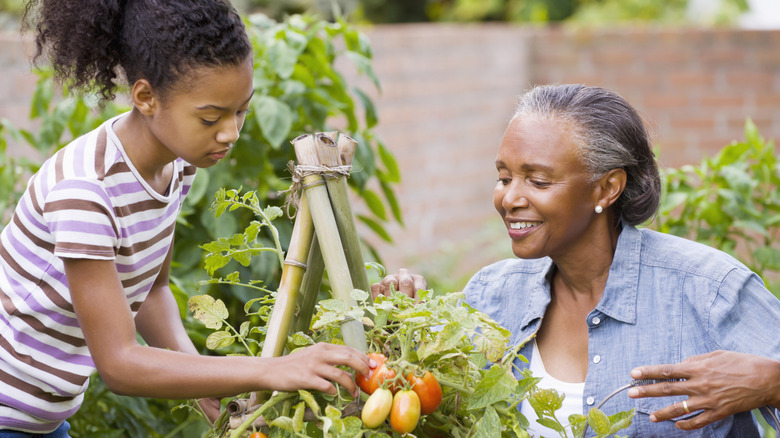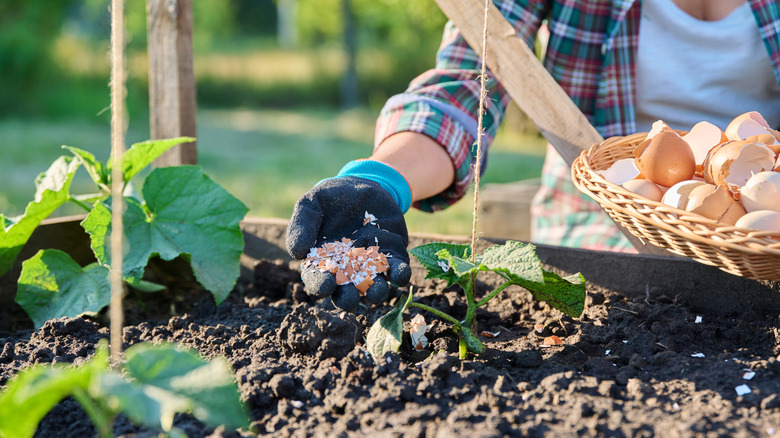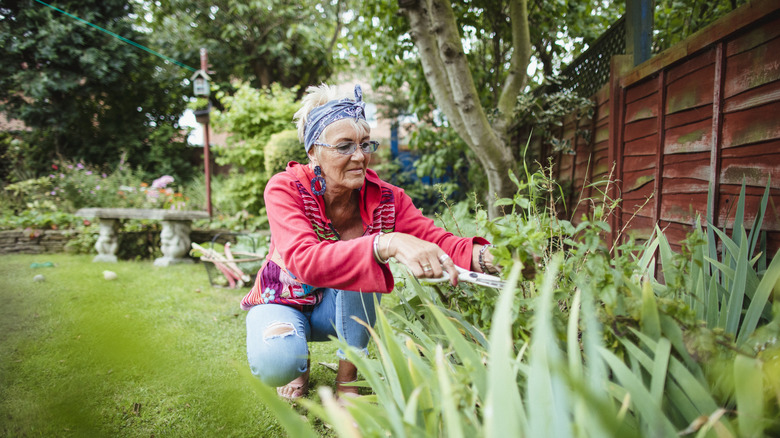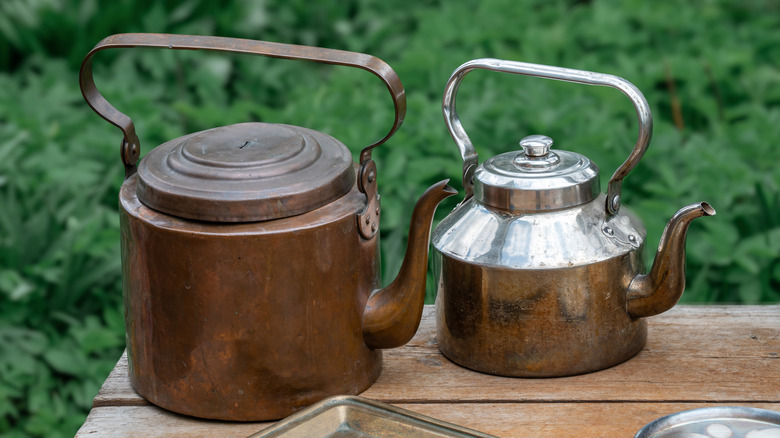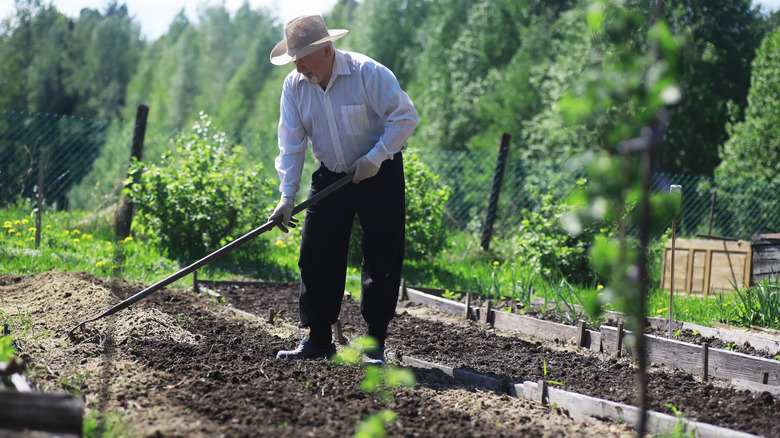12 Old-School Gardening Tricks You'll Wish Grandma Told You About
We may receive a commission on purchases made from links.
It's part of human nature for previous generations to pass down what they know and have learned throughout their lives. Many old-school gardening tips have been handed down for decades, and while some have been discredited, many still remain relevant. Modern studies reveal that a few of these vintage hacks have some scientific backing, and there's an explainable reason for how and why they've benefitted gardens for decades or centuries.
Below are 12 old gardening hacks that have withstood the test of time. These are tips from grandparents, great-grandparents, and beyond that benefit your garden using everyday household items. The following gardening strategies boost plant nutrition, ensure healthy growing habits, deter pests, and have numerous other beneficial effects in gardens of various sizes.
Check out our list of reputable gardening strategies you may have heard from your grandmother or grandfather. We cover why these hacks work, the science behind them, and how to implement them in a garden. We also explore any potential downsides, like how many of them work best when used alongside other methods or have important caveats to keep in mind to help you avoid making any gardening mistakes.
Tums can give tomatoes a nutrient boost
One of the biggest threats to tomatoes is blossom end rot. This condition can directly result from a calcium deficiency, which is reversible by adding minerals to the soil. Some farmers add calcium using bone meal, foliar spray, lime, wood ash, or gypsum, but an unconventional method involves ground-up Tums. Tums contain calcium carbonate, the nutrient plants like tomatoes, cucumbers, and watermelon need to thrive and defend themselves from blossom end rot.
There are multiple ways to go about this "hack." You can drop crushed calcium carbonate tablets into the soil around the tomato's root ball, or you can blend Tums with water and use that mixture on your plants. In both methods, these tablets add calcium, but will only be helpful if the soil is actually deficient. Sometimes, there's already plenty of calcium in the soil, but plants aren't absorbing it because they don't have enough water. Improve your watering schedule by learning everything you should know about watering tomatoes for a healthy yield. While doctoring your tomato bushes with a few Tums could be a convenient (and effective) solution in a pinch, it's probably not the most cost-effective way to rectify low calcium levels across your garden. For this, bulk-size fertilizing options will probably be a better bet. For instance, a box of Down to Earth Organic Bone Meal Fertilizer costs just slightly more than a large tub of Tums, but will allow you to fertilize 100-200 square feet of ground, or over 100 pot plants.
Use beer to trap slugs
Did you know that beer can help keep pesky slugs out of the garden? The yeast in beer attracts snails and slugs and makes a perfect trap if you strategize correctly, as these little creatures will end up drowning in it if you leave out a dish of beer that they can crawl into. According to a citizen science experiment conducted by Garden Organic, both lager and bitter does the job (although lager had a slight lead in their experiments).
Since the bait is intended to attract snails and slugs, set up the beer trap at a distance from your garden. The yeast attracts molluscs already in your yard, but might also draw ones from far away. It's rumored that slugs and snails can smell things over 600 feet away, and beer traps could create homing beacons that lead to even larger infestations. Set up the beer trap as far away from your garden as possible, using plastic Tupperware or the cut-off bottom half of a plastic bottle. Fill it up about 2 to 3 inches with beer and dig a hole in the ground so the trap is almost level with the soil's surface. Check the traps daily, emptying them as they fill up with slugs.
Clip the ends of seeds to jump-start germination
Snipping off the ends of your seeds sounds like a risky method, but there is solid science behind this hack. The more proper term for this is "scarification," which is the process of altering a seed so that water and gases can more easily access it. This occurs naturally over time in nature, but can also be forced by scratching or clipping the seed coat with a metal file, knife, sandpaper, or scissors.
It's easier to do on larger seeds, since you must be careful not to break too much of the outer coating. Use scissors or clippers to snip the edge from one end of the seed and plant it immediately. The longer you wait to plant them, the less likely the plant is to germinate, since the protective outer covering is broken and the kernel inside isn't as protected. Stratification is a common method used on forbs, such as legumes and various wildflower species, making this a good option if you're struggling to grow these plant types in your home garden. Keep in mind that other factors are necessary to incite germination, too. It's not just about breaking open and exposing the seed. Some seeds have other requirements and may need to go through a chilling period before germination (known as stratification).
Finely ground eggshells are a rich source of calcium
Tums aren't the only common household essential that nutritionally benefit garden plants. Another traditional method for adding calcium to soil is crumbling up eggshells. Roughly 95% of an eggshell is calcium carbonate, and the remaining 5% is made up of other minerals. When eggshells finely ground, they release calcium into the soil where it can be absorbed into nearby plants. The effectiveness of this method, though, relies on how you crush the eggshells.
This hack is only effective if you use finely crushed/ground eggshells. This is because eggshells do not decompose at a rate that will benefit garden soil– to illustrate, eggshells are often even found in archeological digs. However a 2005 study from Alabama Cooperative Extension showed that finely ground eggshell powder does break down and significantly increases extractable calcium levels in soil. It's recommended to use a coffee grinder to grind them up. Another method involves boiling the eggshells in water to create a liquid calcium solution. The same caveats that apply to the Tums hack also apply to this eggshell method. It won't boost plants if there is already sufficient calcium in the soil. Improper irrigation could also be the reason why your garden is lacking in nutrition — plants need water to absorb nutrients, including calcium. Avoid common mistakes when watering your garden, and it could solve the issue you thought was a calcium deficiency.
Singing and speak to plants as you garden to encourage better growth
A big debate is whether or not plants can hear and comprehend. "The Secret Life of Plants" and "The Sound of Music and Plants" were two controversial books that discussed how plants react to human voices and music. Unsurprisingly, many skeptics have quickly shut these notions down. However, studies actually back the claims. Various studies that exposed plants to music have emerged with clear findings that growth and biomass rates are in fact affected by the tunes. For example, when Canadian engineer Eugene Canby played Bach's violin sonata to his wheat fields, he had a 66% increase in yield. Not all music is the same, though, as Dorothy Retallack noted in her book "The Sound of Music and Plants." Retallack found that plants grew towards speakers playing classical and jazz music, and away from those emitting "discordant" rock music.
The logic also isn't as simple as "plants enjoy classical music" — there is potential scientific reasoning behind this hack. Plants grow using a protoplasmic streaming process in which they move nutrients and proteins in their fluids (cytoplasm), and it's believed that musical vibrations expedite this process, thereby boosting plant growth. A 2014 study in the Journal of Integrative Agriculture found that certain frequencies at specific volumes increased nutrient uptake and cell division in tested plants, improved photosynthesis, and materially increased yields.
There are also theories that human speech can benefit plant growth. Of course, spending time talking to plants also means gardeners might be around their greenery more, which leads to extra care and attention. If you want to experiment with either of these hacks, keep in mind that not all plants are the same, even under the exact same conditions. Essentially, two identical plants can grow differently because they're individual living organisms. Experiments with sound and plants contain so many variables that it's difficult to draw conclusive proof at home. But, talking and playing relaxing music for plants sounds pretty blissful for all concerned, so you may as well take your grandmother's advice.
Bury used teabags in the garden to improve the soil
Brewing tea hasn't changed much over the centuries, and many people still make it using teabags as their grandmothers did. The next time you brew a cup of tea using a traditional teabag, follow this old gardening trick and toss the used teabag in your garden instead of the garbage. Bags made of abaca fiber, cornstarch, sugarcane, and other biodegradable materials break down in garden soil alongside tea leaves. The tea leaves release nutrients as they decompose and can have direct benefits for the soil. Gardening expert Chris Ware told Express, "Tea bags contain beneficial compounds that improve soil structure, retain moisture, and provide plants with essential nutrients."
Before burying teabags among your plants, make sure they're 100% biodegradable to avoid contaminating your garden with plastic. Many teabags contain microplastics, which can accumulate and cause various issues in the soil and plants, like diminished germination, soil fertility, and stunted root growth. And if you use loose-leaf tea, you can always buy your own biodegradable tea bags, such as the Aksuaple Eco-Fil Disposable Tea Filter Bags.
Use human or animal hair to deter wildlife
People with long hair can benefit from an old-fashioned gardening tip using strands of human hair. Strategically placing hair around a garden could deter larger garden pests, like deer and rabbits. In fact, hair from any perceived predator may help, such as fur saved from dogs and cats. Hair is considered an area repellent. The human odors reportedly discourage deer and rabbits, though the effectiveness of the results are varied.
You can either apply hair to plants and beds, or stuff it into burlap or mesh bags, then hang or place these bags around your garden, hooking them on fenceposts or established, mature plants. Another method is tucking clumps of hair deep in garden leaves without bagging it. It may take multiple bags of hair to make a difference, and it may not deter deer entirely. In some cases, it's only been reported to slow deer down, not stop them completely. For the best results, you should use this hair-based hack alongside further pest-preventative measures, like planting deer-resistant plants to help save your garden or using other methods to keep rabbits from destroying your garden. To secure the large quantities of hair needed for make this hack successful, you might need to source some from a salon or pet groomer.
Spicy peppers can put off pests
Most animals (humans included) are affected by spicy foods, like peppers. This is because peppers contain the chemical capsaicin, which literally sets off a chemical reaction in the body, including an increase in body temperature and the body's subsequent response of activating its cooling systems. It's relatively harmless to people, but capsaicin disrupts insect nervous systems and damages membranes, causing dysfunction that can kill them. Therefore, a very strong solution can work to both repel and eliminate infestations.
Use any type of spicy pepper containing capsaicin to deter bugs. Cayenne, habanero, jalapeño, and other chili peppers are all potential options. Blend the chopped or ground peppers with water, and strain out the pieces before applying the spicy water to attacked plants or insect infestations. You can also add garlic (which contain pest-repelling sulfides), castile soap, or insecticidal soap (Garden Safe's Ready-to-Use Insecticidal Soap is a popular option) to make your homemade pesticide more effective and long-lasting.
This would be an ideal pesticide if not for one important caveat. Capsaicin doesn't just target the bad bugs, it also kills species that benefit your garden. Be careful not to directly spray bees, butterflies, moths, or other beneficial bug species that protect your garden and aid with pollination.
Repurpose empty milk jugs as mini greenhouses for frost-sensitive seedlings
There are several ways to repurpose empty milk jugs for your garden, and one of the most popular old-school methods is to protect frost-sensitive seedlings. Sheltering tender annuals under plastic jugs allows you to plant them out as early as possible, by providing a layer of protection against late frosts. People have been devising ways to get a head start on the planting season for centuries, and back in our great grandparents' time, the go-to method was using cold frames and cloches. In the 1960s, plastic milk jugs came into being, and apart from their main purpose of holding milk, happen to be a handy, free alternative to traditional cloches.
As demonstrated in the above video, all you have to do is remove the bottom of the jug and place it over any young, tender plants. Leave the cap off during the day so the heat can vent. When temperatures freeze over at night, screw on the cap on to protect the plants.
Pour boiling water over new weed growth
With so many herbicides and chemicals on the market, it's easy to forget that some age-old practices are still effective for eradicating weeds. Eliminate newly sprouted weeds in your garden by filling a kettle with tap water, boiling it, and simply pouring it over new weed growth. Boiling water acts as a contact herbicide, meaning it'll kill the parts of the plant it touches directly. This works well on young weeds with shallow root systems, as the boiling water can easily scald them and their roots. The heat disrupts the cell structure, killing whatever it directly touches without harming nearby plants.
Note the use of the word "touches" — the boiling water doesn't know the difference between a desirable plant and an undesirable one, so it's crucial you do not pour it on any greenery you want to keep. Use tea kettles with narrow spouts, which you can find under store tags like "precision pour" or "gooseneck style." The Primula Precision Pour Over Kettle, for example, is just as useful for killing weeds as it is for heating up water for pour-over coffee.
Save nylon pantyhose to use as plant ties to support garden growth
Nylon pantyhose and stockings took off in the 1930s amid the Great Depression, so naturally, our grandparents and great-grandparents found ways to repurpose this asset for other household uses. Stretchy nylon stockings are a good temporary material for securing growing plants to stakes, trellises, arbors, etc. Gardening expert Bill Canaday told Hartley Botanic that pieces of pantyhose are great for holding up plants because "they don't chafe or cut the vine." The soft and permeable material allows light, moisture, and air through, and the stretchiness ensures that the strips of stockings won't choke growing stems.
Performing this trick isn't an exact science. Simply cut the nylon to the length you need to support each plant stem or branch and affix it to nearby fences or garden stakes. This is a popular practice for vining plants, like cucumbers and tomatoes. You can also use entire stockings to support large fruits, such as melons, so they don't fall off the vines when they get too heavy.
If you don't already have a fence or garden stakes to serve as a base, you may need to make a purchase for this hack. The Bovitro 18-Inch Natural Garden Bamboo Plant Stakes come with plenty of pieces for young fruits and vegetables. Remember that nylon is synthetic and not biodegradable. You should replace it when it starts deteriorating to prevent the synthetic fibers from shedding into the garden soil and your environment. If you don't have any old pantyhose on hand, you can also try something like this Garden String from Maquihan on Amazon, or these nifty velcro-style Chzkvoy Anti-Slip Nylon Plant Ties & Straps.
Walk on seeds instead of burying them
Many small seeds are better off being surface sowed, where, as the term suggests, seeds are sprinkled directly on the soil surface. Tiny seeds don't have the physical power to push through a heavy soil layer like larger seeds do, and minimizing how hard they have to work can improve germination rates. Other species like dill, Dahlberg daisies, lettuce, lisianthus, wax begonias, and snapdragons, need light to germinate, and so do best when surface-sown. An old grandmother's trick is to sprinkle seeds over the ground and walk on them so they're gently pressed into the soil without being buried by a thick layer of dirt. Some of the seeds you can potentially plant are wildflowers, carrots, lettuce, onions, and various herbs.
There is one caveat though: This method is probably best suited to light, fluffy, and sandy soils, and the idea isn't to stomp the seeds into the ground, but merely to apply some gentle pressure, lightly tamping them in. If your soil is mostly clay-based and prone to compaction, walking on the surface (even gently) will press it down, making it overly dense and hindering new root growth. Surface sowing also comes with some risks. You must keep the surface moist by watering at least once a day since the topmost layer is prone to drying out. If there are many birds and insects in your area, you may need to invest in something like this Meuallikit Ultra Fine Garden Netting as a pest barrier to give your seeds a chance to sprout without being eaten. This netting is also useful later on when fruits and vegetables start to grow. It'll keep pests from stealing ripening produce as plants mature and reach fruiting age.
